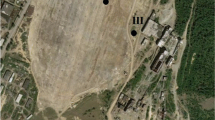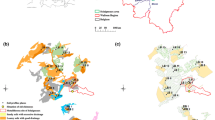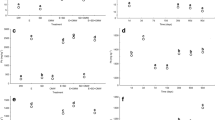Abstract
Despite the wide use of trace metals in various technologies, such as chemical industries and electronic equipment, insufficient information is available on their behavior in the environment. We investigated changes in chemical forms and vertical distribution during the migration processes of trace metals, whose usage is currently increasing rapidly, such as Ag, In, Sn, Sb, and Bi, in soil contaminated with the equivalent of 50–100 times the background concentrations of these metals using an indoor control type monolith lysimeter filled with Andosol during an 8-year monitoring period. The vertical distribution of the total elemental concentrations, the mobile fractions (exchangeable, carbonate-bound, and metal–organic complex-bound) in soils, and the total elemental concentrations in soil solutions were analyzed to study trace metal migration in soil. Except for In, most of the added metals were retained in the uppermost (0–2 cm) soil layer, even after 8 years. However, In markedly migrated downward and accumulated at a depth of approximately 15 cm after 8 years. Furthermore, 10.0 ± 2.9 μg L−1 of In was detected in soil solution at a depth of 17.5 cm. The mobility of In was probably caused by the acidity of the soil, because the pH of the soil between 0 and 15-cm depth was 5 and below, and soluble hydro-oxides, such as In(OH) 03 aq and In(OH) +2 , might be produced at this pH. Consequently, the remarkable mobility of In occurred in Andosol, which strongly retains various trace metals. The proportions of the mobile fractions observed in this study indicated that the mobility of the five metals in Andosol occurred in the order In > Bi ≥ Sb ≥ Sn > Ag.










Similar content being viewed by others
References
Ainsworth N, Cooke JA, Johnson MS (1990) Distribution of antimony in contaminated grassland: 1-vegetation and soils. Environ Pollut 65:65–77. doi:10.1016/0269-7491(90)90165-9
Allen RG, Howell TA, Pruitt WO, Walter IA, Jensen ME (1991) Lysimeters for evapotranspiration and environmental measurements. American Society of Civil Engineers, New York
Asami T (2001) The harmful metal pollution of japanese soil to show by the data. Agune Gijutsu Center, Tokyo (in Japanese)
Baasansuren J, Okazaki M, Choi IS, Toyota K (2002) Tin concentrations in river/bay sediments of Tokyo in 1984 and 2000. Soil Sci Plant Nutr 48:667–672
Baes CFJ, Mesmer RE (1976) The hydrolysis of cations. Krieger publishing Company, Malabar
Belzile N, Chen YW, Wang ZJ (2001) Oxidation of antimony (III) by amorphous iron and manganese oxyhydroxides. Chem Geol 174:379–387. doi:10.1016/S0009-2541(00)00287-4
Blakemore LC, Searle PL, Daly BK (1987) Methods for chemical analysis of soils. NZ Soil, Bureau Scientific Report 80, NZ Soil Bureau, Lower Hutt
Buschmann J, Sigg L (2004) Antimony(III) binding to humic substances: influence of pH and type of humic acid. Environ Sci Technol 38:4535–4541. doi:10.1021/es049901o
Cameron KC, Smith NP, Mclay CDA, Fraser PM, McPherson RJ, Harrison DF, Harbottle P (1992) Lysimeters without edge flow: an improved design and sampling procedure. Soil Sci Soc Am J 56:1625–1628
Cao XD, Ma LQ, Chen M, Hardison DW, Harris WG (2003a) Weathering of lead bullets and their environment effects at outdoor shooting ranges. J Environ Qual 32:526–534
Cao XD, Ma LQ, Chen M, Hardison DW, Harris WG (2003b) Lead transformation and distribution in the soils of shooting ranges in Florida, USA. Sci Total Environ 307:179–189. doi:10.1016/S0048-9697(02)00543-0
Elbana TA, Sparks DL, Selim HM (2014) Transport of tin and lead in soils: miscible displacement experiments and second-order modeling. Soil Sci Soc Am J 78:701–712. doi:10.2136/sssaj2013.07.0265
Filella M (2011) Antimony interactions with heterogeneous complexants in waters, sediments and soils: a review of data obtained in bulk samples. Earth Sci Rev 107(3–4):325–341. doi:10.1016/j.earscirev.1011.04.002
Filella M, Williams PA (2012) Antimony interactions with heterogeneous complexants in waters, sediments and soils: a review of binding data for homologous compounds. Chem Erde 72(S4):49–65. doi:10.1016/j.chemer.2012.01.006
Filella M, Belsile N, Chen YW (2002) Antimony in the environment: a review focused on natural waters II. Relevant solution chemistry. Earth Sci Rev 59:265–285. doi:10.1016/S0012-8252(02)00089-2
Filella M, Belzile N, Lett M-C (2007) Antimony in the environment: a review focused on natural waters. III. Microbiota relevant interactions. Earth Sci Rev 80:195–217. doi:10.1016/j.earscirev.2006.09.003
Filella M, Williams PA, Belzile N (2009) Antimony in the environment: knowns and unknowns. Environ Chem 6:95–105. doi:10.1071/EN09007
Fuhr F, Hance RJ (eds) (1992) Lysimeter studies of the fate of pesticides in the soil. BCPC Monograph No. 53, BCPC
Fuhr F, Hance RJ, Plimmer JR, Nelson JO (eds) (1998) The lysimeter concept, environmental behavior of pesticides. American Chemical Society, Washington
Fujimori T, Takigami H, Agusa T, Eguchi A, Bekki K, Yoshida A, Terazono A, Ballesteros FC (2012) Impact of metals in surface matrices from formal and informal electronic-waste recycling around Metro Manila, the Philippines, and intra-Asian comparison. J Hazard Mater 221:139–146. doi:10.1016/j.jhazmat.2012.04.019
Gee GW, Bauder JW (1986) Particle-size analysis. In: Klute A (ed) Methods of soil analysis part 1, agronomy 9. SSSA Inc Publisher, Wisconsin, pp 383–411
Graedel TE, Erdmann L (2012) Will metal scarcity impede routine industrial use? MRS Bull 4:325–331. doi:10.1557/mrs.2012.34
Gustafsson JP (2016) Visual MINTEQ, 3.1 edn. KTH Royal Institute of Technology, Department of Land and Water Resources Engineering, Stockholm, Sweden. https://vminteq.lwr.kth.se/
Hammel W, Debus R, Steubing L (2000) Mobility of antimony in soil and its availability to plants. Chemosphere 41:1791–1798. doi:10.1016/S0045-6535(00)00037-0
Hara M, Nakazawa K, Katayama K, Sakamura H, Yasui I (2003) Elution characteristics of lead solder and lead-free solder under pseudo-environments. J Jpn Inst Electron Packag 6:173–176 (in Japanese with English summary)
Hashimoto Y, Takeuchi S, Mitsunobu S, Ok YS (2017) Chemical speciation of silver (Ag) in soils under aerobic and anaerobic conditions: Ag nanoparticles vs. ionic Ag. J Hazard Mater 322:318–324. doi:10.1016/j.jhazmat.2015.09.001
Hockmann K, Lenz M, Tandy S, Nachtegaal M, Janousch M, Schulin R (2014a) Release of antimony from contaminated soil induced by redox changes. J Hazard Mater 275:215–221. doi:10.1016/j.jhazmat.2014.04.065
Hockmann K, Tandy S, Lenz SR (2014b) Antimony leaching from contaminated soil under manganese- and iron-reducing conditions: column experiments. Environ Chem 11:24–631. doi:10.1071/EN14123
Hou H, Takamatsu T, Koshikawa MK, Hosomi M (2005a) Migration of silver, indium, tin, antimony, and bismuth and variations in their chemical fractions on addition to uncontaminated soils. Soil Sci 170:624–639. doi:10.1097/01.ss.0000178205.35923.66
Hou H, Takamatsu T, Koshikawa MK, Hosomi M (2005b) Trace metals in bulk precipitation and through fall in a suburban area of Japan. Atom Environ 39:3583–3595. doi:10.1016/j.atmosenv.2005.02.035
Hou H, Takamatsu T, Koshikawa MK, Hosomi M (2006) Concentrations of Ag, In, Sn, Sb and Bi, and their chemical fractionation in typical soils in Japan. Eur J Soil Sci 57:214–227. doi:10.1111/j.1365-2389.2005.00731.x
Hou H, Yao N, Li JN, Wei Y, Zhao L, Zhang J, Li FS (2013) Migration and leaching risk of extraneous antimony in three representative soils of China: lysimeter and batch experiments. Chemosphere 93:1980–1988. doi:10.1016/j.chemosphere.2013.07.017
Itai T, Otsuka M, Asante KA, Muto M, Opoku-Ankomah Y, Ansa-Asare OD, Tanabe S (2014) Variation and distribution of metals and metalloids in soil/ash mixtures from Agbogbloshie e-waste recycling site in Accra, Ghana. Sci Total Environ 470:707–716. doi:10.1016/j.scitotenv.2013.10.03
IUSS Working Group WRB (2014) World reference base for soil resources 2014, World soil, resources reports no. 106. FAO, Rome
Jacobson AR, Klitzke S, McBride MB, Baveye P, Steenhuis TS (2005) The desorption of silver and thallium from soils in the presence of a chelating resin with thiol functional groups. Water Air Soil Pollut 160:41–54. doi:10.1007/s11270-005-3860-3
Johansson M, Pell M, Stenstrom J (1998) Kinetics of substrate-induced respiration (SIR) and denitrification: applications to a soil amended with silver. Ambio 27:40–44
Jones KC, Peterson PJ, Davies BE (1983) Silver concentrations in Welsh soils and their dispersal from derelict mine sites. Mineral Environ 5:122–127. doi:10.1007/BF02093333
Jung MC, Thornton I, Chon H (2002) Arsenic, Sb and Bi contamination of soils, plants, waters and sediments in the vicinity of the Dalsung Cu-W mine in Korea. Sci Total Environ 295:81–89. doi:10.1016/S0048-9697(02)00042-6
Kabata-Pendias A (2011) Trace elements in soils and plants, 4th edn. Taylor & Francis Group, New York
Kong L, He M (2016) Mechanisms of Sb(III) photooxidation by the excitation of organic Fe(III) complexes. Environ Sci Technol 50:6974–6982. doi:10.1021/acs.est.6b00857
Kong L, He M, Hu XY (2016) Rapid photooxidation of Sb(III) in the presence of different Fe(III) species. Geochim Cosmochim Acta 180:214–226. doi:10.1016/j.gca.2016.02.022
Krishnamurti GSR, Huang PM, Vanrees KCJ, Kozak LM, Rostad HPW (1995) Speciation of particulate-bound cadmium of soils and its bioavailability. Analyst 120:659–665. doi:10.1039/an9952000659
Ladenberger A, Demetriades A, Reimann C, Birke M, Sadeghi M, Uhlbäck J, Andersson M, Jonsson E, The GEMAS Project Team (2015) GEMAS: indium in agricultural and grazing land soil of Europe—its source and geochemical distribution patterns. J Geochemi Explor 154:61–80. doi:10.1016/j.gexplo.2014.11.020
Leuz AK, Moench H, Johnson CA (2006) Sorption of Sb(III) and Sb(V) to goethite: influence on Sb(III) oxidation and mobilization. Environ Sci Technol 40:7277–7282. doi:10.1021/es061284b
Lin ZX, Comet B, Qvarfort U (1995) The chemical and mineralogical behavior of Pb in shooting range soils from central Sweden. Environ Pollut 89:303–309. doi:10.1016/0269-7491(94)00068-O
Lintschinger J, Michalke B, Schulte-Hostede S, Schramel P (1998) Studies on speciation of antimony in soil contaminated by industrial activity. Int J Environ Anal Chem 72:11–25. doi:10.1080/03067319808032641
McBride MB, Richards BK, Steenhuis T, Spiers G (1999) Long-term leaching of trace elements in a heavily sludge-amended silty clay loam soil. Soil Sci 164:613–623. doi:10.1097/00010694-199909000-00001
McComb KA, Craw D, McQuillan AJ (2007) ATR-IR spectroscopic study of antimonate adsorption to iron oxide. Langmuir 23:12125–12130. doi:10.1021/la7012667
Mitsunobu S, Tahakashi Y, Terada Y (2010) μ-XANES evidence for the reduction of Sb(V) to Sb(III) in soil from Sb mine tailing. Environ Sci Technol 44:1281–1287. doi:10.1021/es902942z
Mitsunobu S, Takahashi Y, Utsunomiya S, Marcus MA, Terada Y, Iwamura T, Sakata M (2011) Identification and characterization of nanosized tripuhyite in soil near Sb mine tailings. Am Mineral 96:1171–1181. doi:10.2138/am.2011.3651
Murata T (2006) Effects of bismuth contamination on the growth and activity of soil microorganisms using thiols as model compounds. J Environ Sci Health Part A 41:161–172. doi:10.1080/10934520500349276
Murata T (2010) Bismuth solubility through binding by various organic compounds and naturally occurring soil organic matter. J Environ Sci Health Part A 45:746–753. doi:10.1080/10934521003651465
Murata T, Koshikawa MK, Takamatsu T (2005) Effects of Pb, Cu, Sb, in and Ag contamination on the proliferation of soil bacterial colonies, soil dehydrogenase activity, and phospholipid fatty acid profiles of soil microbial communities. Water Air Soil Pollut 164:103–118. doi:10.1007/s11270-005-2254-x
Persson L, Bergstrom L (1991) Drilling method for collection of undisturbed soil monoliths. Soil Sci Soc Am J 55:285–287
Pickering WF (1986) Metal ion speciation—soils and sediments (a review). Ore Geol Rev 1:83–146
Settimio L, McLaughlin MJ, Kirby JK, Langdon KA, Lombi E, Donner E, Scheckel KG (2014) Fate and lability of silver in soils: effect of ageing. Environ Pollut 1(91):151–157. doi:10.1016/j.envpol.2014.04.030
Sillen LG, Martell AE (1964) Part II organic including macromolecule ligands, in stability constants of metal-ion complexes, special publication No 17. The Chemical Society, London
Simpson SL, Angel BM, Jolley DF (2004) Metal equilibration in laboratory-contaminated (spiked) sediments used for the development of whole-sediment toxicity tests. Chemosphere 54:597–609. doi:10.1016/j.chemosphere.2003.08.007
Smith EB, Swanger LK (2000) Toxicity and worldwide environmental regulation of lead-free solders. Trans Inst Metal Finish 78:B18–B21
Soil Survey Staff (2014) Keys to soil taxonomy, 12th edn. USDA-Natural Resources Conservation Service, Washington
Steely S, Amarasiriwardena D, Xing BS (2007) An investigation of inorganic antimony species and antimony associated with soil humic acid molar mass fractions in contaminated soils. Environ Pollut 148:590–598. doi:10.1016/j.envpol.2006.11.031
Suda A, Makino T (2015) Methodological drawbacks of the extraction of trace metals from Fe and Mn oxides in soil samples with oxalic acid-ammonium oxalate-ascorbic acid solution. Water Air Soil Pollut 226:12. doi:10.1007/s11270-014-2285-2
Suda A, Makino T, Higashi T (2011) Applicability of selective dissolution of manganese oxide by acidified 0.1 M NH2OH–HCl in Japanese soils. Geoderma 163:291–295. doi:10.1016/j.geoderma.2011.04.015
Suda A, Makino T, Higashi T (2013) An improved selective extraction method for Mn oxides and occluded metals with emphasis on applicability to Andisols. Soil Sci Plant Nutr 59:840–851. doi:10.1080/00380768.2013.857580
Takamatsu T, Koshikawa MK, Watanabe M, Hou H, Murata T (2007) Design of a meso-scale indoor lysimeter for undisturbed soil to investigate the behaviour of solutes in soil. Eur J Soil Sci 58:329–334. doi:10.1111/j.1365-2389.2006.00843.x
Takamatsu T, Murata T, Koshikawa MK, Watanabe M (2010) Weathering and dissolution rates among Pb shot pellets of differing elemental compositions exposed to various aqueous and soil conditions. Arch Environ Contam Toxicol 59:91–99. doi:10.1007/s00244-009-9449-x
Takeuchi S, Hashimoto Y, Yamaguchi N, Toyota K (2016) Chemical speciation and enzymatic impact of silver in antimicrobial fabric buried in soil. J Hazard Mater 317:602–607. doi:10.1016/j.jhazmat.2016.06.027
Tella M, Pokrivski GS (2012) Stability and structure of pentavalent antimony complexes with aqueous organic ligands. Chem Geol 292–293:57–68. doi:10.1016/j.chemgeo.2011.11.004
Tessier A, Campbell PGC, Bisson M (1976) Sequential extraction procedure for the speciation of particulate trace metals. Anal Chem 51(7):844–851
Wen F, Hou H, Yao N, Yan ZG, Bai LP, Li FS (2013) Effects of simulated acid rain, EDTA, or their combination, on migration and chemical fraction distribution of extraneous metals in Ferrosol. Chemosphere 90:349–357. doi:10.1016/j.chemosphere.2012.07.027
White SJO, Hemond HF (2012) The anthrobiogeochemical cycle of indium: a review of the natural and anthropogenic cycling of indium in the environment. Crit Rev Environ Sci Technol 42:155–186. doi:10.1080/10643389.2010.498755
Wood SA, Samson IM (2006) The aqueous geochemistry of gallium, germanium, indium and scandium. Ore Geol Rev 28:57–102. doi:10.1016/j.oregeorev.2003.06.002
Yi W, Halliday AN, Lee DC, Christensen JN (1995) Indium and tin in basalts, sulfides, and the mantle. Geochim Cosmochim Acta 59:5081–5090. doi:10.1016/0016-7037(95)00342-8
Zaborowska M, Kucharski J, Wyszkowska J (2016) Biological activity of soil contaminated with cobalt, tin, and molybdenum. Environ Monit Assess 188:398. doi:10.1007/s10661-016-5399-8
Acknowledgements
The authors thank Dr. A. Tanaka, Ms. M. Okawa, Ms. M. Hirano, Ms. F. Sato, Ms. S. Kinoshita, and Ms. R. Kumata at NIES for their assistance in measuring elemental concentrations (using ICP-AES, -MS, and CHN analyzers). They also thank the informative comments, especially about chemical forms of indium, from the anonymous reviewers. This study was supported by a Grant for Environmental Research Projects from a Grant for Scientific Research of Waste Management from the Ministry of the Environment of Japan (K1639) and a Next Generation Environment-Friendly Soldering Technology (EFSOT) project (prime contractor: Hitachi Ltd.) as part of the Intelligent Manufacturing Systems (IMS) program.
Author information
Authors and Affiliations
Corresponding author
Rights and permissions
About this article
Cite this article
Murata, T., Koshikawa, M.K., Watanabe, M. et al. Migration of Ag, In, Sn, Sb, and Bi and Their Chemical Forms in a Monolith Lysimeter Filled with a Contaminated Andosol. Arch Environ Contam Toxicol 74, 154–169 (2018). https://doi.org/10.1007/s00244-017-0437-2
Received:
Accepted:
Published:
Issue Date:
DOI: https://doi.org/10.1007/s00244-017-0437-2




